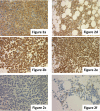The histopathology of myeloma in the bone marrow
- PMID: 29998977
- PMCID: PMC6413148
- DOI: 10.3960/jslrt.18014
The histopathology of myeloma in the bone marrow
Abstract
Myeloma is characterized by the neoplastic proliferation of monoclonal plasma cells. A diagnosis of myeloma is based on the criteria proposed by the International Myeloma Working Group and the pathological findings.Myeloma cells are classified into four types: mature, immature, pleomorphic, and plasmablastic. There are three patterns in which myeloma infiltrates bone marrow - nodular, interstitial, and diffuse. Dutcher bodies are highly specific to neoplastic myeloma cells. On immunohistochemical staining, the specificity of CD138 is high for plasma cells. As a clear image is often not obtained from the immunohistochemical staining of the immunoglobulin light chain, in situ hybridization is recommended. Abnormal expression of CD56 is seen in 70-80% of cases by flow cytometry analysis. CD56 expression definitively indicates myeloma, suggesting its high diagnostic value. Evaluation of the infiltration pattern, monoclonality, and abnormal antigen expression of plasma cells is more important than the plasmocytic ratio to determine whether a case is reactive or neoplastic.Multiple gene abnormalities function in the onset and progression of myeloma. In our department, we analyze CCND1, FGFR3, MAF, and del (17p13) by FISH for all myeloma cases. None of the cases with genetic abnormalities were recognized by G-banding. Therefore, FISH is more effective than G-banding for the evaluation of genetic abnormalities in myeloma.
Keywords: Bone marrow; FISH method; Genetic abnormality; Myeloma; Pathological finding.
Conflict of interest statement
Figures





References
-
- Greipp PR, Leong T, Bennett JM, et al. Plasmablastic morphology--an independent prognostic factor with clinical and laboratory correlates: Eastern Cooperative Oncology Group (ECOG) myeloma trial E9486 report by the ECOG Myeloma Laboratory Group. Blood. 1998; 91: 2501-2507. - PubMed
Publication types
MeSH terms
LinkOut - more resources
Full Text Sources
Other Literature Sources
Medical
Research Materials

